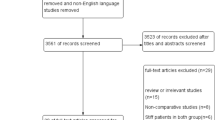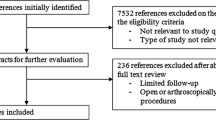Abstract
Introduction
To determine whether immobilization after arthroscopic rotator cuff repair improved tendon healing compared with early passive motion.
Materials and methods
A systematic electronic literature search was conducted to identify randomized controlled trials (RCTs) comparing early passive motion with immobilization after arthroscopic rotator cuff repair. The primary outcome assessed was tendon healing in the repaired cuff. Secondary outcome measures were range of motion (ROM) and American Shoulder and Elbow Surgeons (ASES) shoulder scale, Simple Shoulder Test (SST), Constant, and visual analog scale (VAS) for pain scores. Pooled analyses were performed using a random effects model to obtain summary estimates of treatment effect with 95 % confidence intervals. Heterogeneity among included studies was quantified.
Results
Three RCTs examining 265 patients were included. Meta-analysis revealed no significant difference in tendon healing in the repaired cuff between the early-motion and immobilization groups. A significant difference in external rotation at 6 months postoperatively favored early motion over immobilization, but no significant difference was observed at 1 year postoperatively. In one study, Constant scores were slightly higher in the early-motion group than in the immobilization group. Two studies found no significant difference in ASES, SST, or VAS score between groups.
Conclusion
We found no evidence that immobilization after arthroscopic rotator cuff repair was superior to early-motion rehabilitation in terms of tendon healing or clinical outcome. Patients in the early-motion group may recover ROM more rapidly.
Level of evidence
Level II; systematic review of levels I and II studies.







Similar content being viewed by others
References
Boileau P, Brassart N, Watkinson DJ, Carles M, Hatzidakis AM, Krishnan SG (2005) Arthroscopic repair of full-thickness tears of the supraspinatus: does the tendon really heal? J Bone Joint Surg Am 87:1229–1240
Galatz LM, Ball CM, Teefey SA, Middleton WD, Yamaguchi K (2004) The outcome and repair integrity of completely arthroscopically repaired large and massive rotator cuff tears. J Bone Joint Surg Am 86-A:219–224
Flurin PH, Landreau P, Gregory T, Boileau P, Brassart N, Courage O et al (2005) Arthroscopic repair of full-thickness cuff tears: a multicentric retrospective study of 576 cases with anatomical assessment. Rev Chir Orthop Reparatrice Appar Mot 91:31–42
Kluger R, Bock P, Mittlbock M, Krampla W, Engel A (2011) Long-term survivorship of rotator cuff repairs using ultrasound and magnetic resonance imaging analysis. Am J Sports Med 39:2071–2081
Vastamaki M, Lohman M, Borgmastars N (2013) Rotator cuff integrity correlates with clinical and functional results at a minimum 16 years after open repair. Clin Orthop Relat Res 471:554–561
Lafosse L, Brozska R, Toussaint B, Gobezie R (2007) The outcome and structural integrity of arthroscopic rotator cuff repair with use of the double-row suture anchor technique. J Bone Joint Surg Am 89:1533–1541
Huijsmans PE, Pritchard MP, Berghs BM, van Rooyen KS, Wallace AL, de Beer JF (2007) Arthroscopic rotator cuff repair with double-row fixation. J Bone Joint Surg Am 89:1248–1257
Tashjian RZ, Hollins AM, Kim HM, Teefey SA, Middleton WD, Steger-May K et al (2010) Factors affecting healing rates after arthroscopic double-row rotator cuff repair. Am J Sports Med 38:2435–2442
Goutallier D, Postel JM, Gleyze P, Leguilloux P, Van Driessche S (2003) Influence of cuff muscle fatty degeneration on anatomic and functional outcomes after simple suture of full-thickness tears. J Shoulder Elbow Surg 12:550–554
Sugaya H, Maeda K, Matsuki K, Moriishi J (2007) Repair integrity and functional outcome after arthroscopic double-row rotator cuff repair. A prospective outcome study. J Bone Joint Surg Am 89:953–960
Mihata T, Watanabe C, Fukunishi K, Ohue M, Tsujimura T, Fujiwara K et al (2011) Functional and structural outcomes of single-row versus double-row versus combined double-row and suture-bridge repair for rotator cuff tears. Am J Sports Med 39:2091–2098
Tudisco C, Bisicchia S, Savarese E, Fiori R, Bartolucci DA, Masala S et al (2013) Single-row vs. double-row arthroscopic rotator cuff repair: clinical and 3 Tesla MR arthrography results. BMC Musculoskelet Disord 14:43
Duquin TR, Buyea C, Bisson LJ (2010) Which method of rotator cuff repair leads to the highest rate of structural healing? A systematic review. Am J Sports Med 38:835–841
Bey MJ, Ramsey ML, Soslowsky LJ (2002) Intratendinous strain fields of the supraspinatus tendon: effect of a surgically created articular-surface rotator cuff tear. J Shoulder Elbow Surg 11:562–569
Gimbel JA, Van Kleunen JP, Williams GR, Thomopoulos S, Soslowsky LJ (2007) Long durations of immobilization in the rat result in enhanced mechanical properties of the healing supraspinatus tendon insertion site. Biomech Eng 129:400–404
Thomopoulos S, Williams GR, Soslowsky LJ (2003) Tendon to bone healing: differences in biomechanical, structural, and compositional properties due to a range of activity levels. J Biomech Eng 125:106–113
Li S, Min SX, Zhang H, Fu GJ, Wang PC, Jin AM (2010) Effect of continuous passive motion on basic fibroblast growth factor expression during tendon-bone repair after surgical repair of acute rupture of the supraspinatus tendon in rabbits. Nan Fang Yi Ke Da Xue Xue Bao 30:1020–1023
Parsons BO, Gruson KI, Chen DD, Harrison AK, Gladstone J, Flatow EL (2010) Does slower rehabilitation after arthroscopic rotator cuff repair lead to long-term stiffness? J Shoulder Elbow Surg 19:1034–1039
Cuff DJ, Pupello DR (2012) Prospective randomized study of arthroscopic rotator cuff repair using an early versus delayed postoperative physical therapy protocol. J Shoulder Elbow Surg 21:1450–1455
Arndt J, Clavert P, Mielcarek P, Bouchaib J, Meyer N, Kempf JF (2012) Immediate passive motion versus immobilization after endoscopic supraspinatus tendon repair: a prospective randomized study. Orthop Traumatol Surg Res 98:S131–138
Kim YS, Chung SW, Kim JY, Ok JH, Park I, Oh JH (2012) Is early passive motion exercise necessary after arthroscopic rotator cuff repair? Am J Sports Med 40:815–821
Higgins JP, Altman DG, Gotzsche PC, Juni P, Moher D, Oxman AD et al (2011) The Cochrane Collaboration’s tool for assessing risk of bias in randomised trials. BMJ 343:d5928
Higgins JP, Thompson SG, Deeks JJ, Altman DG (2003) Measuring inconsistency in meta-analyses. BMJ 327:557–560
Huberty DP, Schoolfield JD, Brady PC, Vadala AP, Arrigoni P, Burkhart SS (2009) Incidence and treatment of postoperative stiffness following arthroscopic rotator cuff repair. Arthroscopy 25:880–890
Seo SS, Choi JS, An KC, Kim JH, Kim SB (2012) The factors affecting stiffness occurring with rotator cuff tear. J Shoulder Elbow Surg 21:304–309
Millett PJ, Wilcox RB 3rd, O’Holleran JD, Warner JJ (2006) Rehabilitation of the rotator cuff: an evaluation-based approach. J Am Acad Orthop Surg 14:599–609
Franceschi F, Ruzzini L, Longo UG, Martina FM, Zobel BB, Maffulli N et al (2007) Equivalent clinical results of arthroscopic single-row and double-row suture anchor repair for rotator cuff tears: a randomized controlled trial. Am J Sports Med 35:1254–1260
Aydin N, Kocaoglu B, Guven O (2010) Single-row versus double-row arthroscopic rotator cuff repair in small- to medium-sized tears. J Shoulder Elbow Surg 19:722–725
Peltz CD, Dourte LM, Kuntz AF, Sarver JJ, Kim SY, Williams GR et al (2009) The effect of postoperative passive motion on rotator cuff healing in a rat model. J Bone Joint Surg Am 91:2421–2429
Sarver JJ, Peltz CD, Dourte L, Reddy S, Williams GR, Soslowsky LJ (2008) After rotator cuff repair, stiffness–but not the loss in range of motion–increased transiently for immobilized shoulders in a rat model. J Shoulder Elbow Surg 17:108S–113S
Author information
Authors and Affiliations
Corresponding author
Rights and permissions
About this article
Cite this article
Shen, C., Tang, ZH., Hu, JZ. et al. Does immobilization after arthroscopic rotator cuff repair increase tendon healing? A systematic review and meta-analysis. Arch Orthop Trauma Surg 134, 1279–1285 (2014). https://doi.org/10.1007/s00402-014-2028-2
Received:
Published:
Issue Date:
DOI: https://doi.org/10.1007/s00402-014-2028-2




